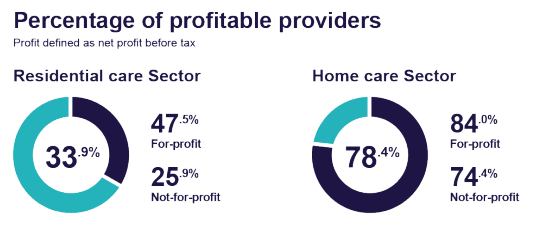The Department of Health and Aged Care has recently published the inaugural Quarterly Financial Snapshot (QFS) of the Australian aged care sector for quarter 1 of the 2022-23 financial year.
Recognising the longstanding underfunding of Australia's aged care sector, the Royal Commission has acknowledged the need to improve its financial sustainability.
Consequently, the Australian Government has made it a priority to reform the sector through various initiatives, designed to enhance transparency and introduce structural changes.
The Quarterly Financial Reporting system provides the information required to support these initiatives. The recently released QFS indicates the aged care sector, including residential aged care and home care packages, continues to have a significantly declining financial performance. The sector's financial sustainability remains a challenge, and the shortage of staffing capacity has severely affected care service delivery across all levels of aged care, with 66% of residential aged care homes reporting operating losses for the period July to September 2022.
Source: Quarterly Financial Snapshot of the Aged Care Sector Quarter 1 2022-23 July to September 2022
Residential aged care homes across all geographic sectors have reported an average operating loss of $27.90 per bed day. This equates to an annual loss of $7,092 per bed, which, when extrapolated, indicates a total residential sector loss of over $465.3 million for the three-month period.
It's important to acknowledge that the QFS results incorporate expenses that are non-recurring, such as Covid-19 and capital expenditure, however losses at this rate are unsustainable for the industry and require swift response.
The implementation of the AN-ACC subsidy model starting from 1 October 2022, could bring about a financial advantage during the transition period as the subsidy covers extra direct care staffing minutes, which are not mandatory until 1 October 2023. Nonetheless, a significant portion of this benefit may be diminished since the AN-ACC's initial price may be inadequate due to the unanticipated rise in award staff expenses and inflation that were not accounted for during the funding cost estimation.
Upon release of the QFS, Minister for Aged Care Anika Wells addressed the aged care reforms: “The new AN-ACC model has been implemented, funding for 24/7 registered nurses is rolling out and we have committed to funding the aged care workforce value case – these changes will support the future of Australia’s aged care service providers’ finances and operations for the long term.”
have committed to funding the aged care workforce value case – these changes will support the future of Australia’s aged care service providers’ finances and operations for the long term.”
Nevertheless, a significant factor contributing to this issue has been the shortage of staff, which has resulted in a substantial increase in overtime and the necessity for agency workers to ensure that the needs of residents are being adequately addressed. In addition, the introduction of the mandatory care time standard and the concerning current occupancy levels will combine to adversely impact the necessary investment required from both new and existing providers.
The fundamental problem is that the financial benefits of the reforms will not be immediately realised upon their implementation, but rather there will be a delay of several years before they have a positive impact on financial performance. This delay is likely to create a point of pressure, and there may be a need for short-term remedial assistance. For more information on the Quarterly Financial Snapshot, please click here.
FOR MORE INFORMATION
Please reach out to Ray Scott (National Director – Aged Care) if you would like to discuss your specific circumstances.






